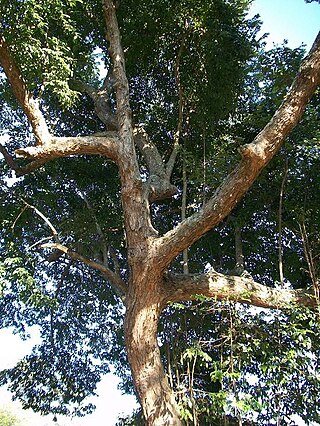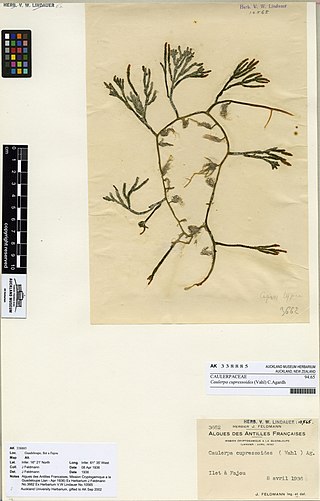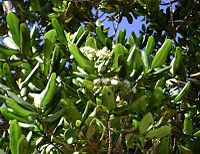
The bay leaf is an aromatic leaf commonly used as a herb in cooking. It can be used whole, either dried or fresh, in which case it is removed from the dish before consumption, or less commonly used in ground form. The flavor that a bay leaf imparts to a dish has not been universally agreed upon, but most agree it is a subtle addition.

Abietic acid is an organic compound that occurs widely in trees. It is the primary component of resin acid, is the primary irritant in pine wood and resin, isolated from rosin and is the most abundant of several closely related organic acids that constitute most of rosin, the solid portion of the oleoresin of coniferous trees. Its ester or salt is called an abietate. As the chief component of rosin, it is approved by FDA as a miscellaneous food additive.

Myrciaria floribunda, commonly known as cambuizeiro, guavaberry or rumberry, is a species of plant in the family Myrtaceae. It can be found across South and Central America and the West Indies in dry or moist coastal woodlands, up to 300 metres above sea level. The guavaberry, which should not be confused with the guava, is a close relative of camu camu.

Caulerpa racemosa is a species of edible green alga, a seaweed in the family Caulerpaceae. It is commonly known as sea grapes and is found in many areas of shallow sea around the world. Despite the name, it is not related to grapes. There are a number of different forms and varieties, and one that appeared in the Mediterranean Sea in 1990, which is giving cause for concern as an invasive species.

Ricinodendron is a plant genus in the family Euphorbiaceae first described as a genus in 1864. It includes only one known species, Ricinodendron heudelotii, native to tropical Africa from Senegal + Liberia east to Sudan and Tanzania and south to Mozambique and Angola. It produces an economically important oilseed. The tree is known as munguella (Angola), njangsa (Cameroon), bofeko (Zaire), wama (Ghana), okhuen (Nigeria), kishongo (Uganda), akpi, djansang, essang, ezezang and njasang. Two varieties of the tree species are recognized R. heudelotii var. heudelotii in Ghana and R. heudelotii var. africanum in Nigeria and westwards.

Hydrocotyle umbellata is an aquatic plant that thrives in wet, sandy habitat. Its English common name is manyflower marshpennywort or dollarweed. It is native to North America and parts of South America. In Brazil it is known as acariçoba and has applications in herbal medicine with purported anxiolytic, analgesic and anti-inflammatory properties. It can also be found growing as an introduced species and sometimes a noxious weed on other continents. It is an edible weed that can be used in salads or as a pot herb.

Kuding is a particularly bitter-tasting Chinese infusion, which due to their similarities in appearance is derived from several plant species. The two most common plants used to make kuding are the wax tree species Ligustrum robustum and the holly species Ilex kaushue, the former being more commonly grown in Sichuan and Japan while the latter is most commonly grown and used in the rest of China. Tea produced from Ligustrum or many species of Ilex is caffeine-free, although not Ilex paraguariensis, the source of mate drank in South America.

Pimenta is a genus of flowering plants in the myrtle family, Myrtaceae described as a genus in 1821. It is native to Central and South America, Mexico, and the West Indies.
Bay-rum tree sometimes is used as a reference to two plants:

Heritiera littoralis, commonly known as the looking-glass mangrove or tulip mangrove, is a mangrove tree in the family Malvaceae native to coastal areas of eastern Africa, Asia, Melanesia and northern Australia. The common name refers to the silvery appearance of the underside of the leaves, resembling a mirror to some degree. The strong timber has uses in marine applications and elsewhere.

Barringtonia acutangula is a species of Barringtonia native to coastal wetlands in southern Asia and northern Australasia, from Afghanistan east to the Philippines, Queensland and the Northern Territory. Common names include freshwater mangrove, itchytree and mango-pine.
Uvariopsis tripetala is a species of plant in the Annonaceae family. It is found in Ghana and Nigeria. It is threatened by habitat loss.

Danae is a monotypic genus of flowering plants. The single species, Danae racemosa, is native to west Asia. It is a slow-growing evergreen shrub about 60 cm in diameter and its common names are Alexandrian laurel and poet's laurel. In the APG III classification system, Danae is placed in the family Asparagaceae, subfamily Nolinoideae.

Calliandra surinamensis is a low branching evergreen tropical shrub that is named after Suriname, a country in northern South America. The plant usually has complexly branched multiple trunks and grows to a height of about 5 metres, although many sources suggest that it only attains a height of 3 metres. Left unpruned it grows long thin branches that eventually droop down onto the ground. The leaves close and droop from dusk until morning when they once again reopen. Calliandra surinamensis is said to contain lectins which are toxic to cancer cells, although more research is needed. Calliandra surinamensis contains three important compounds: myrectin which contains antioxidant and anti-inflammatory properties, lupeol which contains anti-inflammatory and anti-cancer properties, and ferulic acid which contains antimicrobial properties.

Margaritaria discoidea is a tree in the family Phyllanthaceae, commonly known as the pheasant-berry, egossa red pear or bushveld peacock-berry. These trees are native to the warmer, higher rainfall areas of Africa.

Eryngium foetidum is a tropical perennial herb in the family Apiaceae. Common names include culantro, recao, chadon beni, Mexican coriander, bandhaniya, long coriander, Burmese coriander, sawtooth coriander, and ngò gai. It is native to Mexico, the Caribbean, and Central and South America, but is cultivated worldwide, mostly in the tropics as a perennial, but sometimes in temperate climates as an annual.

Lupeol is a pharmacologically active pentacyclic triterpenoid. It has several potential medicinal properties, like anticancer and anti-inflammatory activity.
Pimenta pseudocaryophyllus, popularly known as cataia, craveiro or louro-cravo, is a species from the family Myrtaceae.

Caulerpa cupressoides, commonly known as cactus tree alga, is a species of seaweed in the Caulerpaceae family. Green alge of Caulerpa genus are salty and pungent in style and are consumed by several marine cultures around the world.
Cordia salicifolia, also called Cordia ecalyculata and chá de bugre, is a species of evergreen flowering tree in the borage family, Boraginaceae, that occurs mainly in Brazil and is used as a medicinal plant. Its red fruit, which resembles a coffee bean and contains caffeine, is roasted and brewed as a coffee substitute.




















